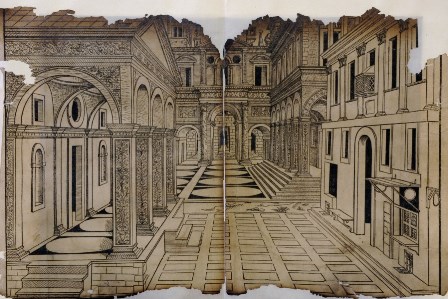
WTI Magazine #57 2015 April, 3
Author : Enrico De Iulis Translation by:
In Reggio Emilia a very special and important ongoing exhibition is having a huge success: "Piero della Francesca. The design of art and science". It is not an easy exhibition, where math and geometry are the protagonists in equal measure with major minor arts. Despite the apparent difficulty of the subject, there is instead a whole side of the Renaissance world that opens in front of our eyes, following a tangle of disciplines we are now use to firmly separate by creating disciplinary fences, but that in the fifteenth and sixteenth century lived in a mixture daily existence of artists and mathematicians.
Everything starts from the daring story of the manuscript currently stored in the municipal library of Reggio Emilia, one of the most beautiful examples of "De prospectiva pingendi": the essay of Renaissance perspective that has finally been in Reggio Emilia for nearly a century, after wandering among Italian private collections all over Italy between 1700 and 1800.
Around this copy is reunited, after nearly a millennium, the whole essay production from Piero della Francesca, consisting of six other copies of "De prospectiva" (stored in Bordeaux, London, Paris, Milan and Parma), the two versions of ''Abaco" (both in Florence), the "Libellus" (stored in the Vatican City) and the "Archimedes", discovered only about ten years ago.
Besides this initial fundamental core, the exhibition is enriched by some of Piero's paintings, contemporary paintings of other important artists, ceramics, prints, marquetry, drawings and engravings that all show how mathematics is fundamental to Renaissance art.
Geometry was very important to Piero, who was a tireless and well-trained scholar of this matter: thanks to these studies, architecture was constantly present in its art. Famous people like the mathematician Luca Pacioli and Daniele Barbaro, who translated Vitruvius' "de Architectura" , have long analyzed Piero's studies: the very concept of the ideal Renaissance city reflected the close connection between geometry and human life, and between mathematics and every object and space man meets in his everyday life.
Some of the tables present in the essays have been reported in three-dimensional model specifically for this exhibition, giving a news sense to the progression of scientific discoveries that will be the basis of the mastery of Leon Battista Alberti and other Renaissance architects. Some suggestive multimedia installations let the visitors to fully understand the perspective in the essays of that time and the close connection between the study of figured spaces and the one of human body in the fifteenth century.
This is not a very commercial exhibition, very refined and maybe complex, but it is nevertheless important to understand how, during the Renaissance, many categories nowadays separated were in full osmosis for those who lived then, intertwined issues in many human activities. Besides, the exhibition is instrumental to realize how, without artists like Piero della Francesca, Leonardo da Vinci and Leon Battista Alberti, the sense of civil engineering as we know it today might not even exist.



